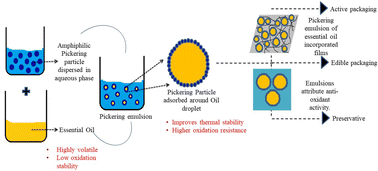Insights into headway in essential oil-based Pickering emulsions for food applications
Abstract
Essential oils are popular, but the direct application of EOs in food as a preservative is limited as they are highly volatile, and the high flavour of EOs affects the sensory characteristics of the food. The incorporation of EOs into Pickering emulsions (PEs) is explored in detail because of their superlative properties and finds a wide range of applications. The application of PEs as a delivery system for essential oils (EOs) has gained popularity due to the thermal stability, controlled release, and enhanced protection of EOs compared to conventional emulsions. Pickering particles offer higher stability, controllable release properties, and stimuli-responsive behaviour compared to traditional emulsions stabilised by surfactants, making them an area of interest. The presence of Pickering particles at the interface improves emulsion properties and protects the oil properties compared to conventional emulsion systems. This review critically addresses the recent advances in the preparation and characterisation methods pertaining to EO-based PEs, their advantages and disadvantages, their application in the food sector, and their future prospects.



 Please wait while we load your content...
Please wait while we load your content...